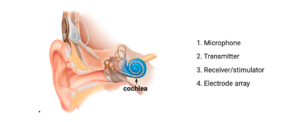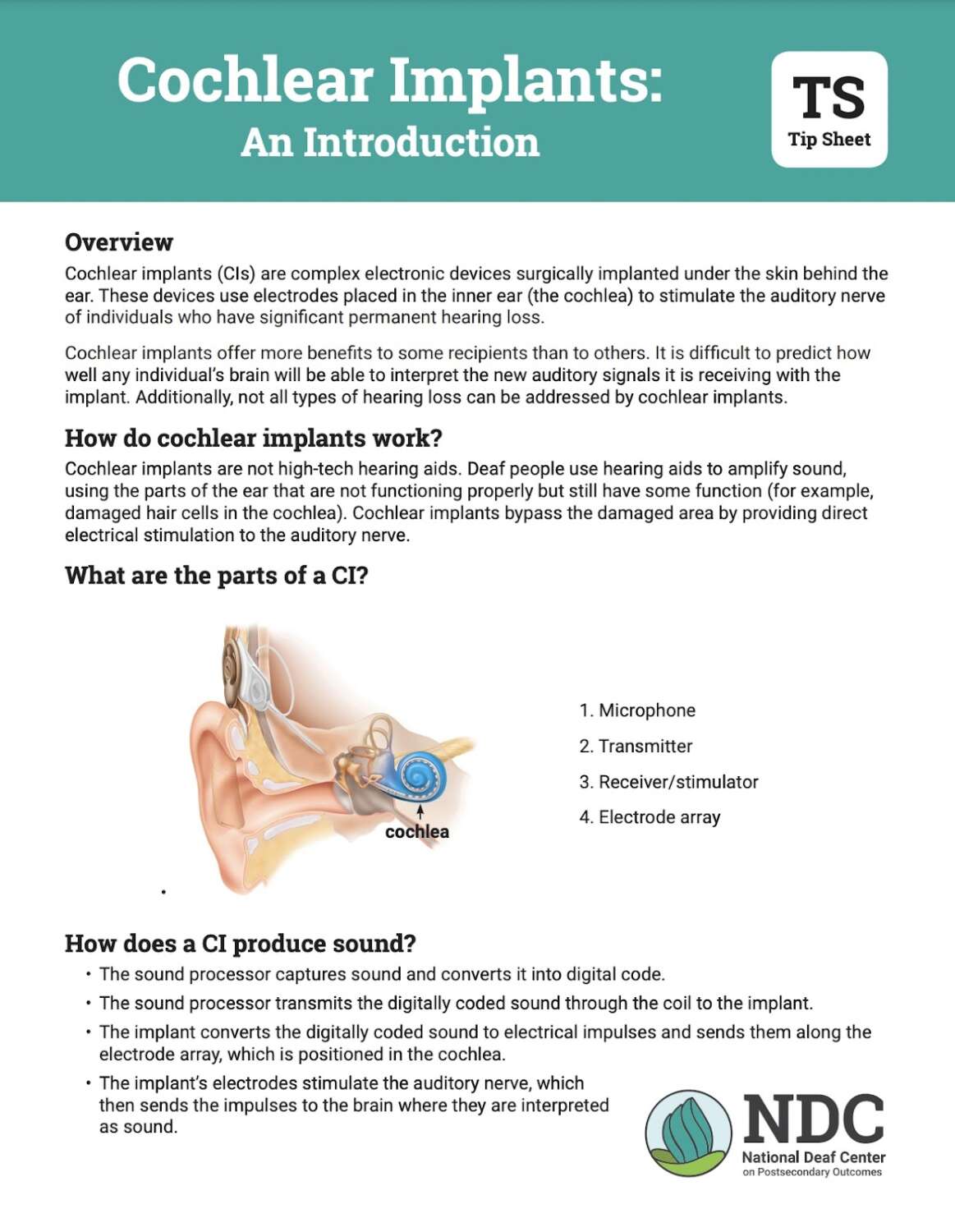Overview
Cochlear implants (CIs) are complex electronic devices surgically implanted under the skin behind the ear. These devices use electrodes placed in the inner ear (the cochlea) to stimulate the auditory nerve of people who have significant permanent hearing loss.
Cochlear implants offer more benefits to some recipients than to others. It is difficult to predict how well any individual’s brain will be able to interpret the new auditory signals it is receiving with the implant. Additionally, not all types of hearing loss can be addressed by cochlear implants.
How do cochlear implants work?
Cochlear implants are not high-tech hearing aids. Deaf people use hearing aids to amplify sound, using the parts of the ear that are not functioning properly but still have some function (for example, damaged hair cells in the cochlea). Cochlear implants bypass the damaged area by providing direct electrical stimulation to the auditory nerve.
What are the parts of a CI?

How does a CI produce sound?
- The sound processor captures sound and converts it into digital code.
- The sound processor transmits the digitally coded sound through the coil to the implant.
- The implant converts the digitally coded sound to electrical impulses and sends them along the electrode array, which is positioned in the cochlea.
- The implant’s electrodes stimulate the auditory nerve, which then sends the impulses to the brain where they are interpreted as sound.
CIs will not restore hearing to “normal.” When an individual is considered for a CI, the audiologist and otolaryngologist stress the fact that the implant will not result in hearing that is the same as biologic hearing. Benefits vary greatly among people. Some CI users can only pick up on environmental sounds, while others regain enough hearing to use the telephone and recognize music. It is important that recipients and the people around them understand that CIs do not enable a deaf person to function as a hearing person.
Therefore, some people who have CIs might still require accommodations such as ASL interpreters or real-time captioning.
What accommodations will a person with CIs need?
Individuals may have received CIs as early as infancy or as late as adulthood. They may have one CI or two. Coupled with the many variations in CI function as explained above, different backgrounds result in a broad range of listening, speech, speech reading, sign language, literacy, and cognitive abilities.
This variation means that there is not one answer for every person who has a CI. Room acoustics play a major role in the intelligibility of speech for people with CIs and also people with hearing aids. The following should be taken into consideration:
- How loud is the signal?
- How clear is the speech?
- How far away is the speaker?
- How much competing noise is there?
- Is the vocabulary familiar?
- Is the speaker organized or rambling?
- Is there one speaker or many?
- How long has the individual had the CI?
- Did the individual have exposure to spoken language before the hearing loss occurred?
Some CI users get little enough usable sound that they prefer to use ASL interpreters. Others will prefer real-time captioning. Ultimately, the service coordinator should check in with the individual to find out what kinds of communication environments he or she does well in, and which ones are problematic. It is also important to welcome the individual back for further discussion after he or she has had some experience in the classroom or work environment.
Some people who have CIs are skilled at advocating for themselves. Others may need additional support, especially in a secondary or post-secondary environment.
Tips
DO face the person when talking.
DO speak clearly.
DO repeat a sentence exactly. If still not understood, then choose alternative phrases to express your thoughts.
DO provide preferential seating if requested.
DO monitor environmental noise.
DO monitor environmental light.
DO point out who is talking.
DO repeat questions/comments when leading group discussions.
DO familiarize yourself with assistive listening devices.
DO check in with the individual regarding what kinds of communication environments work best for him or her.
DON’T turn away from the person’s view when speaking.
DON’T exaggerate your speech or shout.
DON’T assume that because a person has a CI, he or she doesn’t know ASL or doesn’t want an interpreter.
DON’T attempt to talk over loud environmental noise; wait for the noise to stop or move to a quieter location.
DON’T speak while you are writing on a board.
DON’T speak with objects in front of your mouth.
DON’T pace around the room while speaking.
DON’T assume that a student or employee is aware of all available support services. Make referrals when appropriate.






